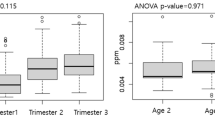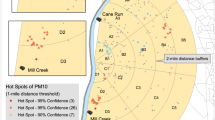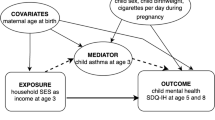Abstract
Few studies have evaluated the association between ambient particulate matter (PM) exposure and childhood attention deficit hyperactivity disorder (ADHD). We explored associations between long-term exposure to ambient PM1 and PM2.5 (particles with airborne diameters of <1 µm and <2.5 µm, respectively) with positive screening for ADHD among 164,081 school-aged children in China. Parents or guardians completed a checklist using DSM-IV, and PM1 and PM2.5 exposures linked via residential addresses were estimated using a spatial statistical model. Long-term exposure to higher ambient PM1 (odds ratio = 1.74; 95% confidence interval = 1.47–2.06 per 10.0 μg m–3) and PM2.5 (odds ratio = 1.65; 95% confidence interval = 1.45–1.88 per 10.0 μg m–3) was associated with greater odds of screening positive for ADHD. The associations were heterogenous across regions, with stronger associations for PM1 exposure than for PM2.5. Our findings highlight the potential importance of ambient PM mass concentrations, sizes, components and sources for protecting children’s neurological health in China, and in the design of interventions to decrease the health burden of children’s ADHD.
This is a preview of subscription content, access via your institution
Access options
Subscribe to this journal
Receive 12 digital issues and online access to articles
$59.00 per year
only $4.92 per issue
Buy this article
- Purchase on Springer Link
- Instant access to full article PDF
Prices may be subject to local taxes which are calculated during checkout
Similar content being viewed by others
Data availability
Data supporting the findings of this study are available in the Supplementary Information.
Code availability
The code for mixed-effects logistic regression models is provided in Supplementary Methods 3.
References
WHO Global Air Quality Guidelines: Particulate Matter (PM2.5 and PM10), Ozone, Nitrogen Dioxide, Sulfur Dioxide and Carbon Monoxide (World Health Organization, 2021).
GBD 2019 Risk Factors Collaborators.2019 Risk Factors Collaborators. Global burden of 87 risk factors in 204 countries and territories, 1990–2019: a systematic analysis for the Global Burden of Disease Study 2019. Lancet 396, 1223–1249 (2020).
Bu, X. et al. Global PM2.5-attributable health burden from 1990 to 2017: estimates from the Global Burden of Disease Study 2017. Environ. Res. 197, 111123 (2021).
Chen, G. et al. Estimating spatiotemporal distribution of PM1 concentrations in China with satellite remote sensing, meteorology, and land use information. Environ. Pollut. 233, 1086–1094 (2018).
Borisova, T. Nervous system injury in response to contact with environmental, engineered and planetary micro- and nano-sized particles. Front. Physiol. 9, 728 (2018).
Meng, X. et al. Size-fractionated particle number concentrations and daily mortality in a Chinese city. Environ. Health Persp. 121, 1174–1178 (2013).
Guxens, M. et al. Associations of air pollution on the brain in children: a brain imaging study. Res. Rep. Health Eff. Inst. 209, 1–61 (2022).
Gheissari, R. et al. Health outcomes in children associated with prenatal and early-life exposures to air pollution: a narrative review. Toxics. 10, 458 (2022).
Thygesen, M. et al. Exposure to air pollution in early childhood and the association with attention-deficit hyperactivity disorder. Environ. Res. 183, 108930 (2020).
Perera, F. P. et al. Combined effects of prenatal exposure to polycyclic aromatic hydrocarbons and material hardship on child ADHD behavior problems. Environ. Res. 160, 506–513 (2018).
Roberts, S. et al. Exploration of NO2 and PM2.5 air pollution and mental health problems using high-resolution data in London-based children from a UK longitudinal cohort study. Psychiatry Res. 272, 8–17 (2019).
Forns, J. et al. Air pollution exposure during pregnancy and symptoms of attention deficit and hyperactivity disorder in children in europe. Epidemiology. 29, 618–626 (2018).
Thapar, A. & Cooper, M. Attention deficit hyperactivity disorder. Lancet 387, 1240–1250 (2016).
Polanczyk, G. V., Salum, G. A., Sugaya, L. S., Caye, A. & Rohde, L. A. Annual research review: a meta-analysis of the worldwide prevalence of mental disorders in children and adolescents. J. Child Psychol. Psychiatry 56, 345–365 (2015).
Chen, G. et al. Effects of ambient PM1 air pollution on daily emergency hospital visits in China: an epidemiological study. Lancet Planet Health 1, e221–e229 (2017).
Diagnostic and Statistical Manual of Mental Disorders, Fourth Edition (American Psychiatric Association, 2002).
Goshua, A., Akdis, C. & Nadeau, K. C. World Health Organization global air quality guideline recommendations: executive summary. Allergy 77, 1955–1960 (2022).
Aghaei, M., Janjani, H., Yousefian, F., Jamal, A. & Yunesian, M. Association between ambient gaseous and particulate air pollutants and attention deficit hyperactivity disorder (ADHD) in children; a systematic review. Environ. Res. 173, 135–156 (2019).
Zhang, M., Wang, C., Zhang, X., Song, H. & Li, Y. Association between exposure to air pollutants and attention-deficit hyperactivity disorder (ADHD) in children: a systematic review and meta-analysis. Int. J. Environ. Health Res. 32, 207–219 (2022).
Chiu, Y. H. et al. Prenatal particulate air pollution and neurodevelopment in urban children: examining sensitive windows and sex-specific associations. Environ. Int. 87, 56–65 (2016).
Fuertes, E. et al. Traffic-related air pollution and hyperactivity/inattention, dyslexia and dyscalculia in adolescents of the German GINIplus and LISAplus birth cohorts. Environ. Int. 97, 85–92 (2016).
Yuchi, W. et al. Neighborhood environmental exposures and incidence of attention deficit/hyperactivity disorder: a population-based cohort study. Environ. Int. 161, 107120 (2022).
Chang, Y. C., Chen, W. T., Su, S. H., Jung, C. R. & Hwang, B. F. PM2.5 exposure and incident attention-deficit/hyperactivity disorder during the prenatal and postnatal periods: a birth cohort study. Environ. Res. 214, 113769 (2022).
Liu, B. et al. Fetal exposure to air pollution in late pregnancy significantly increases ADHD-risk behavior in early childhood. Int. J. Environ. Res. Public Health 19, 10482 (2022).
Fan, H. C. et al. Association between exposure to particulate matter air pollution during early childhood and risk of attention-deficit/hyperactivity disorder in Taiwan. Int. J. Environ. Res. Public Health. 19, 16138 (2022).
Li, J. et al. Differing toxicity of ambient particulate matter (PM) in global cities. Atmos. Environ. 212, 305–315 (2019).
Grahame, T. J. & Schlesinger, R. B. Health effects of airborne particulate matter: do we know enough to consider regulating specific particle types or sources? Inhal. Toxicol. 19, 457–481 (2007).
Habre, R. et al. The effects of PM2.5 and its components from indoor and outdoor sources on cough and wheeze symptoms in asthmatic children. J. Expo. Sci. Environ. Epidemiol. 24, 380–387 (2014).
Li, W. et al. Characteristics and formation mechanism of regional haze episodes in the Pearl River Delta of China. J. Environ. Sci. China. 63, 236–249 (2018).
Fang, D. et al. Chemical composition and health risk indices associated with size-resolved particulate matter in Pearl River Delta (PRD) region, China. Environ. Sci. Pollut. Res. 26, 12435–12445 (2019).
Tao, J. et al. Source apportionment of PM2.5 at urban and suburban areas of the Pearl River Delta region, south China—with emphasis on ship emissions. Sci. Total Environ. 574, 1559–1570 (2017).
Zhao, H. et al. Aerosol and gaseous pollutant characteristics during the heating season (winter–spring transition) in the Harbin–Changchun megalopolis, northeastern China. J. Atmos. Sol. Terr. Phys. 188, 26–43 (2019).
Yin, S. et al. Study on spatial distribution of crop residue burning and PM2.5 change in China. Environ. Pollut. 220, 204–221 (2017).
Wang, C. et al. Summer atmospheric polybrominated diphenyl ethers in urban and rural areas of northern China. Environ. Pollut. 171, 234–240 (2012).
Jin, L. et al. Contributions of city-specific fine particulate matter (PM2.5) to differential in vitro oxidative stress and toxicity implications between Beijing and Guangzhou of China. Environ. Sci. Technol. 53, 2881–2891 (2019).
Yang, M. et al. Is PM1 similar to PM2.5? A new insight into the association of PM1 and PM2.5 with children’s lung function. Environ. Int. 145, 1060922020 (2020).
Zou, Y., Wu, Y., Wang, Y., Li, Y. & Jin, C. Physicochemical properties, in vitro cytotoxic and genotoxic effects of PM1.0 and PM2.5 from Shanghai, China. Environ. Sci. Pollut. Res. Int. 24, 19508–19516 (2017).
Wang, X. et al. Ambient particulate matter (PM1, PM2.5, PM10) and childhood pneumonia: the smaller particle, the greater short-term impact? Sci. Total Environ. 772, 145509 (2021).
Park, E. H., Kim, H. & Heo, J. The impact of size-segregated particle properties on daily mortality in Seoul, Korea. Environ. Sci. Pollut. Res. Int. 29, 45248–45260 (2022).
Wu, Q. Z. et al. Ambient airborne particulates of diameter ≤1 μm, a leading contributor to the association between ambient airborne particulates of diameter ≤2.5 μm and Children’s blood pressure. Hypertension. 75, 347–355 (2020).
Khan, J. Z., Sun, L., Tian, Y., Shi, G. & Feng, Y. Chemical characterization and source apportionment of PM1 and PM2.5 in Tianjin, China: impacts of biomass burning and primary biogenic sources. J. Environ. Sci. China. 99, 196–209 (2021).
Yu, H. et al. A seriously sand storm mixed air-polluted area in the margin of Tarim Basin: temporal–spatial distribution and potential sources. Sci. Total Environ. 676, 436–446 (2019).
Liu, J. et al. Role of PKA/CREB/BDNF signaling in PM2.5-induced neurodevelopmental damage to the hippocampal neurons of rats. Ecotoxicol. Environ. Saf. 214, 112005 (2021).
Wang, Z. et al. Early-life lead exposure induces long-term toxicity in the central nervous system: From zebrafish larvae to juveniles and adults. Sci. Total Environ. 804, 150185 (2022).
Perera, F., Ashrafi, A., Kinney, P. & Mills, D. Towards a fuller assessment of benefits to children’s health of reducing air pollution and mitigating climate change due to fossil fuel combustion. Environ. Res. 172, 55–72 (2019).
Qi, Y. L., Yu, R. L., Wang, Z. C. & XinR, E. Psychometric features of the symptom inventory scale of DSM-IV ADHD in Chinese children [in Mandarin]. Chin Ment Health J. 19, 583–584 (2005).
Yang, B. Y. et al. Association between greenness surrounding schools and kindergartens and attention-deficit/hyperactivity disorder in children in China. JAMA Netw Open 2, e1917862 (2019).
Ren, Y. et al. Predicting the adult clinical and academic outcomes in boys with ADHD: a 7- to 10-year follow-up study in China. Front Pediatr. 9, 634633 (2021).
Chen, G. et al. The comparison of AOD-based and non-AOD prediction models for daily PM2.5 estimation in Guangdong province, China with poor AOD coverage. Environ. Res. 195, 110735 (2021).
Wang, L. B. et al. Association between exposure to outdoor artificial light at night and sleep disorders among children in China. J. Am. Med. Assoc. Netw. Open 5, e2213247 (2022).
Pappas, D. N. ADHD rating scale-IV: checklists, norms, and clinical interpretation. J. Psychoeduc. Assess. 24, 172–178 (2006).
Mortamais, M. et al. Effect of exposure to polycyclic aromatic hydrocarbons on basal ganglia and attention-deficit hyperactivity disorder symptoms in primary school children. Environ. Int. 105, 12–19 (2017).
National Health Commission of the People’s Republic of China. Core Information and Interpretation of Chinese Youth Health Education (2018).
Lawrence, W. R. et al. Pet exposure in utero and postnatal decreases the effects of air pollutants on hypertension in children: a large population based cohort study. Environ. Pollut. 238, 177–185 (2018).
Minatoya, M. et al. Cat and dog ownership in early life and infant development: a prospective birth cohort study of Japan environment and children’s study. Int. J. Environ. Res. Public Health 17, 205 (2019).
Liu, J. et al. Mitigation pathways of air pollution from residential emissions in the Beijing–Tianjin–Hebei region in China. Environ. Int. 125, 236–244 (2019).
Qin, F. et al. Exercise and air pollutants exposure: a systematic review and meta-analysis. Life Sci. 218, 153–164 (2019).
Liu, R.-Q. et al. Association between depressive symptoms and poor sleep quality among Han and Manchu ethnicities in a large, rural, Chinese population. PLoS One 14, e0226562 (2019).
Acknowledgements
The research was funded by the National Natural Science Foundation of China (grant no. 82073502 to R.-Q.L.); the Guangxi Key Research and Development Plan (grant no. GUIKEAB18050024 to G.-H.D.); the research was funded by the National Natural Science Foundation of China (grant nos. 81872582 to G.-H.D.; 81972992 to B.-Y.Y. and 81703179 to B.-Y.Y.); the National Key Research and Development Program of China (grant no. 2018YFE0106900 to X.-W.Z.) and the Fundamental Research Funds for the Central Universities (grant no. 19ykjc01 to G.-H.D.).
Author information
Authors and Affiliations
Contributions
R.-Q.L. designed the study, collected and analyzed the data, and wrote the manuscript. M.S.B. designed the study, analyzed the data and revised the study. Y.G. and B.-Y.Y. collected and analyzed the data, and revised the manuscript. I.M., S.D., P.J., L.K., S.L., L.M. and J.M. analyzed the data and revised the manuscript. X.-Y.Z., M.Y., Y.Z., L.-W.H. and H.-Y.Y. collected and analyzed the data. Y.Y., X.-W.Z. and G.-H.D. conceptualized the study, arranged the investigation, collected data and revised the manuscript.
Corresponding authors
Ethics declarations
Competing interests
The authors declare no competing interests.
Peer review
Peer review information
Nature Mental Health thanks Aaron Reuben, Xueying Zhang and the other, anonymous, reviewers for their contribution to the peer review of this work.
Additional information
Publisher’s note Springer Nature remains neutral with regard to jurisdictional claims in published maps and institutional affiliations.
Supplementary information
Supplementary Information
Supplementary Fig. 1, Supplementary Tables 1–11 and Supplementary Methods 1–3.
Supplementary Data 1
Dataset of the study presented as
Rights and permissions
Springer Nature or its licensor (e.g. a society or other partner) holds exclusive rights to this article under a publishing agreement with the author(s) or other rightsholder(s); author self-archiving of the accepted manuscript version of this article is solely governed by the terms of such publishing agreement and applicable law.
About this article
Cite this article
Liu, RQ., Guo, Y., Bloom, M.S. et al. Differential patterns of association between PM1 and PM2.5 with symptoms of attention deficit hyperactivity disorder. Nat. Mental Health 1, 402–409 (2023). https://doi.org/10.1038/s44220-023-00065-5
Received:
Accepted:
Published:
Issue Date:
DOI: https://doi.org/10.1038/s44220-023-00065-5



